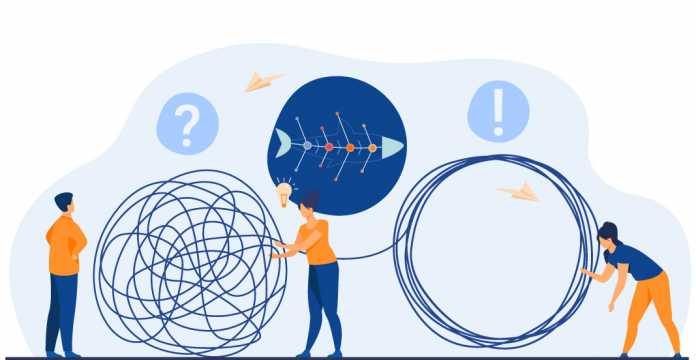
One of the seven essential quality control instruments is the cause and effect diagram or fishbone diagram. The fishbone diagram is distinguishable, although all of these tools possess their importance. You use it in Six Sigma during DMAIC’s “Analyze” phase. DMAIC stands for defining, measuring, analyzing, improving, and controlling.
This diagram got the name, Ishikawa, because it was developed in 1960 by Japanese professor Kaoru Ishikawa. Mr. Ishikawa was a leading specialist in quality management. It is used by project managers and during quality management. There are many names in the Fishbone diagram, Ishikawa diagram, the Herringbone diagram, and the diagram of cause and effect.
It’s hard to find some other tool that has just as many initials!
The Fishbone diagram looks like a fish skeleton; the head is the issue, and the causes are related to the spinal column; therefore, for the same purpose, many specialists call it a fishbone or herringbone diagram, or Ishikawa. Because this tool assists you find the source of the problem, it has got the diagram of cause and effect title.
How to Design A Fishbone Diagram?
It is simple to build a fishbone diagram and needs no advanced knowledge:
Step 1: Learn to state the issue quickly
Set it on the right-hand side of the diagram inside a frame. That is the fish’s “amp.” Then outline a straight line, with a left arrow pointing. That is the skeleton of the fish’s “backbone.”
Step 2: Identify Various Components
Connect the critical types of possible factors as lines up and underneath the fault line at 45-degree angles – similar to the bones like a fish that are attached at the backbone. The American Quality Society (ASQ) advises focusing on these categories of problems:-
- People: Everyone is included in the approach.
- Schemes: How does the mechanism work? What are the necessary criteria, including rules and protocols, for doing so?
- Machines: The instruments or devices utilized to get the job done or achieve the process?
- Elements: The coarse materials or pieces utilized to create the finished product?
- Size: What information does the system yield that will assist us in assessing its quality?
- Background: What are the circumstances, like the place, temperature, and organizational culture, under which the mechanism is operating?
Step 3: Brainstorm Possible Causes
Brainstorm the potential triggers of the problem with each group. If required, you may sub-categorize them. As you think, ask yourself questions such as: “Why does this happen?” Note the answer. Then again ask, “Why does this happen?” You should apply these triggers to the fishbone (factors) horizontally, and mark them. You will continue to incorporate the sub-branches until a satisfactory outcome is obtained.
This is a crucial step; you can spend quite a lot of time here. Causes compilation has to be thorough. This strategy parallels the “5-Why” method, which notes that the exploration of the real root cause needs at least five attempts to answer “Why?”
Step 4: Analyze the Diagram
Your fishbone diagram is finished, and all potential root causes of the problem can be seen.
Now you will explore deeper with your team to find the root cause and the answer.
Importance of Fishbone Diagram
Ishikawa model provides many advantages for the study and problem solving of causes:
- Displays the potential triggers of a given issue in a quick, easy-to-read graphical manner
- Captures and shows the relationships among possible triggers in the table
- A perfect technique to tackle challenging problems where multiple variables need to be weighed
- Stimulates a detailed review and assessment and it helps you to investigate in depth the potential causes
- Gives you a clearer picture of the dilemma and a more in-depth interpretation
- Boosts and brainstorming mechanisms on the possible causes
- Stimulates in-depth discussion of this issue by team members
- Help keep the team focused
- Identify an agent where it doesn’t work
- Issue Identification: How to get to the bottom of it
- It’s not enough to know precisely what issue occurred or could occur
You need solutions, but maybe one explanation does not suffice. The 5 Why s strategy will help you dig beneath the rock. Here’s an example:
Problem: My car won’t start.
- Why isn’t it starting? A rectangular cell
- What is a Flat Battery? The alternator stopped running
- Why had the alternator stopped working? The alternator belt was removed
- Why? Why? It should have been superseded
- Why didn’t they fix it? The car wasn’t headed for their daily operation
- Is the fifth factor behind the root cause? Maybe not
You should ask five more “why” questions, or you could discover that you have found the root cause before you answer the fifth “why.” Preferably, a team that involves any of the workers nearest to the source of the issue can plan the detection of root causes.
Software Programs You Can Apply To Design Fishbone Diagrams
As you can quickly generate a hand-produced fishbone diagram on parchment or a whiteboard, there are additionally a variety of software programs that you can use to create:
Desktop Diagramming Software
- SmartDraw
- EDraw Flowchart
- Nevron Diagram Designer
Web-based Diagramming Apps
- LucidChart
- Create.ly
Mind Mapping Software
- XMind
- ConceptDraw MINDMAP
- MindMapper 12
Summary
A fishbone diagram is a critical instrument for determining the root cause of a problem. Even if it’s time-consuming to use it, the rewards are massive. This method helps isolate the root cause of the issue and creates empathy between team members. For a crucial problem, you use the fishbone model so you can’t waste much time on a minor thing.
To learn more about the Fishbone Diagram and other problem-solving methods, you should consider pursuing popular quality management certification courses from an accredited training provider.
Some of the popular Quality Management Certification courses that individuals and enterprise team members can take up are:
Six Sigma Green Belt Certification
Six Sigma Black Belt Certification Online
Lean Six Sigma Yellow Belt Certification Training
RCA through Six Sigma Training














